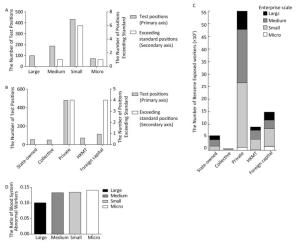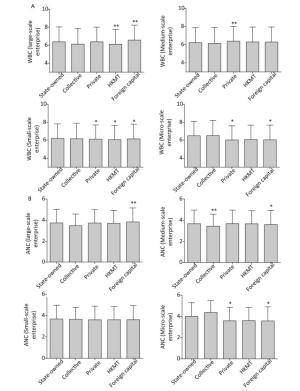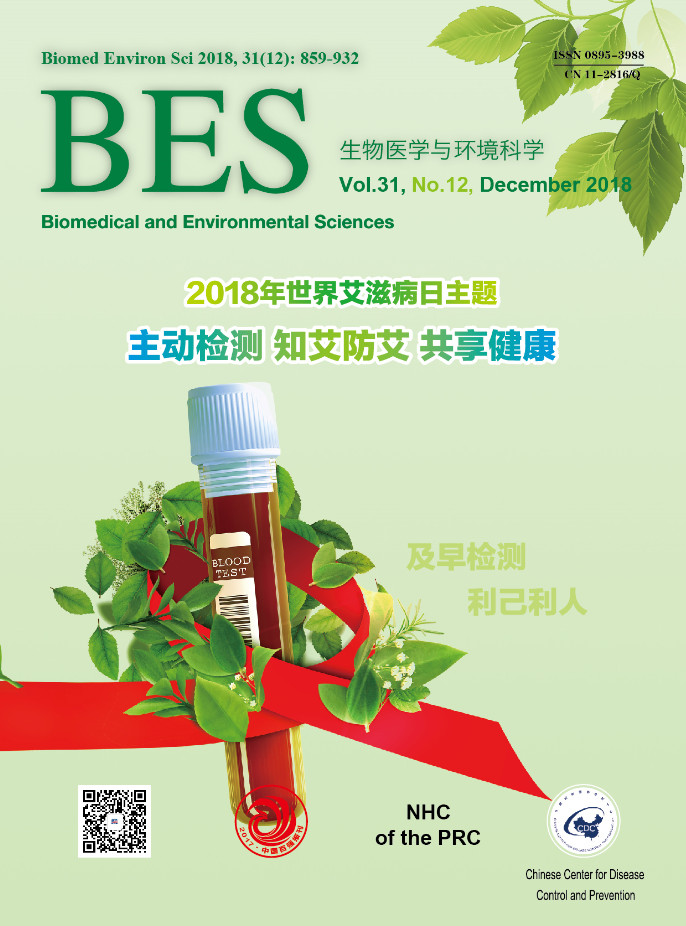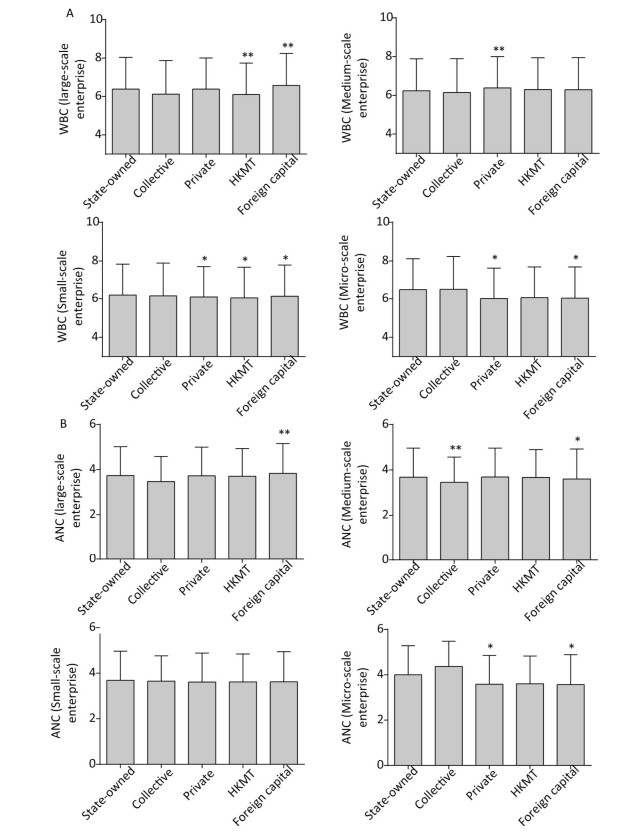-
Benzene is a classified as a human carcinogen that can cause myelodysplastic syndrome and acute myelogenous leukemia[1]. This compound is also a potent toxin suppressing the bone marrow. Accordingly, benzene causes serious hematological adverse effects, such as pancytopenia and aplastic anemia. In the 1920s, the carcinogenicity of benzene was identified in humans, in which it was shown to cause acute myelocytic leukemia (AML)[2]. The reports highlighting the first cases of hematopoietic disease associated with benzene appeared in China in the late 1950s[3]. Moreover, benzene exposure is likely to result in AML, having been identified as a Group Ⅰ carcinogen by the International Agency for Research on Cancer (1987)[4]. A meta-analysis has determined the links existing between childhood leukemia and the numbers of latent benzene exposure metrics[5].
Benzene is among the most extensively utilized industrial chemicals in China, in particular in an extensive array of sectors and professions, especially the shoe and suitcase sectors[6]. In total, 548 cases of chronic occupational poisoning were reported in China. Moreover, more than 18 kinds of chemical substances that cause chronic occupational poisoning, mostly benzene poisoning, were reported in 228 cases[7]. In China, the number of benzene-using employers, the number of benzene-exposed workers, and the extent of the occupational benzene-related harm remain unknown. The data referenced from the National Health and Family Planning Commission in the Occupational Disease Situation Bulletin are inclined to being partial and non-systematic, as the benzene sampling observation for work environment cannot precisely reflect the actual situation of workplaces[8]. Owing to these reasons, we established the Sentinel Surveillance of Occupational Disease[7, 9], a behavioral program aimed at gathering the changing scenarios, together with the associated information from the individuals who have been heavily impacted by the factors known to cause occupational diseases.
The current research aimed at evaluating the occupational benzene exposures and potential effects on workers' health by estimating the number of employees with possible exposure to benzene and assessing the current scenarios of benzene exposure by ambient and hematologic examination in varied sectors operating in the Jiangsu Province.
The current research also compared the hematological parameters from a cohort of benzene-exposed employees from varied types of enterprises. The subjects included in this investigation comprised 102, 384 workers who experienced work-related benzene exposure. The subject recruitment was conducted from the monitoring information system of major work-related disease monitoring information system in Jiangsu Province, China, 2017. In this system, the subjects included employees who worked for more than one year with benzene exposure. The scale of enterprise was in accordance with the division standard, 'Regarding the issuance of the standard of small and medium-sized enterprises; (2011003) 3133 (Supplementary Table S1 available in www.besjournal.com)'. The ownership of enterprise was in accordance with the division standard (Supplementary Table S2 available in www.besjournal.com), 'Classification and code for economic categories (GB/T 12402-2000)'.
Industries and Career Fields Terms Unit Big Mid Small Micro Industry* Employee (X) Number X ≥ 1000 300 ≤ X < 1000 20 ≤ X < 300 X < 20 Revenue (Y) Yuan Y ≥ 4 × 108 2 × 107 ≤ Y < 4 × 108 3 × 106 ≤ Y < 2 × 107 Y < 3 × 106 Construction industry Revenue (Y) Yuan Y ≥ 8 × 108 6 × 107 ≤ Y < 8 × 108 3 × 106 ≤ Y < 6 × 107 Y < 3 × 106 Asset (Z) Yuan Z ≥ 8 × 108 5 × 107 ≤ Z < 8 × 108 3 × 106 ≤ Z < 5 × 107 Z < 3 × 106 Wholesaling Employee (X) Number X ≥ 200 20 ≤ X < 200 5 ≤ X < 20 X < 5 Revenue (Y) Yuan Y ≥ 4 × 108 5 × 107 ≤ Y < 4 × 108 1 × 107 ≤ Y < 5 × 107 Y < 1 × 107 Retailing Employee (X) Number X ≥ 300 50 ≤ X < 300 10 ≤ X < 50 X < 10 Revenue (Y) Yuan Y ≥ 2 × 108 5 × 106 ≤ Y < 2 × 108 1 × 106 ≤ Y < 5 × 106 Y < 1 × 106 Transportation industry*# Employee (X) Number X ≥ 1000 300 ≤ X < 1000 20 ≤ X < 300 X < 20 Revenue (Y) Yuan Y ≥ 3 × 108 3 × 107 ≤ Y < 3 × 108 2 × 106 ≤ Y < 3 × 107 Y < 2 × 106 Note. This table includes all industries and career fields involved in benzene-exposed industries, *including mining, manufacturing, electric power industry, and petroleum industry; #transportation includes ground transportation, ship transport, aviation, and pipeline transport. Table Supplementary Table S1. Standard of Small and Medium-sized Enterprises
Enterprise Ownership Definition Code State-owned enterprise A state-owned enterprise (SOE) is a business enterprise where the state has significant control through full, majority, or significant minority ownership. 100 Collective ownership Collective ownership is the ownership of means of production by all members of a group for the benefit of all its members. 120 Private property Private property is a legal designation for the ownership of property by non-governmental legal entities. Private property can be either personal property (consumption goods) or capital goods. 170 HKMT Hong Kong, Macao, and Taiwan, China ownership or control of a business. 200 Foreign ownership Foreign ownership or control of a business or natural resource in a country by individuals who are not citizens of that country or by companies whose headquarters outside that country 300 Table Supplementary Table S2. Classification and Code for Economic Categories
In 2002, by implementing the fresh Occupational Diseases Prevention and Control Act, a new benzene Organic ElectroLuminescence (OEL) was introduced: 10 mg/m3 as the allowable density of 15 min short-term exposure limit and 6 mg/m3 as the allowable density of 8 h permissible concentration-time weighted average (PC-TWA). In accordance with the Determination of Toxic Substances in the Workplace (GBZ/T160.42-007), the ambient examination of benzene was conducted by gas chromatography (GC/FID, CP-3800, Varian, USA) using a HP-INNOWAX column (0.32 mm o.d., 60 m, film thickness of 0.15 µm) subsequent to extracting by benzene-free carbon disulfide (Sigma, USA). The recovery rate of benzene extraction amounted to 99% in accordance with Air Monitoring Sampling Rules of Toxic Substances in Workplace (GBZ 159-2004) and Determination of Toxic Workplace (GBZ/T 160.42-2007) regulation. Benzene concentration was analyzed for 786 testing points (stationary measurements). In accordance with the Workplace Harmful Factors in the Occupational Exposure Limit (GBZ 2.1-2007) regulation of benzene evaluation, a value of less than 6 mg/m3 was considered qualified.
In 2017, whole blood was extracted from the workers at the commencement of the transfer from the cubital vein using an ethylenediaminetetraacetic acid tube. The hematologic analysis was carried out using an auto analyzer, SYSMEX SF-3000 (TOA Medical Electronics Co., Japan). The measured objects included hemoglobin (Hb), red blood cell (RBC), white blood cell (WBC), blood platelet (PLT), and absolute neutrophil count (ANC). Blood tests results should always be interpreted using the ranges provided by the laboratory that performed the test. Example ranges are shown in Supplementary Table S3 (available in www.besjournal.com).
Abbreviation Stands for Description Low High Unit WBC White Blood Cell Count The level of white blood cells. 4 10 109/L RBC Red Blood Cell Count The level of red blood cells. 4.0 (male)
3.5 (female)5.5 (male)
5.0 (female)1012/L HBC Hemoglobin Level of hemoglobin molecules. 110 (male)
120 (female)150 (male)
160 (female)g/L PLT Platelets Platelets levels in the blood. 100 300 109/L ANC Absolute neutrophil count Absolute neutrophil count in the blood. 2 9 109/L Table Supplementary Table S3. Blood Tests Results
The continuous variables with normal distribution were expressed as mean ± standard deviation (SD). One-way analysis of variance (ANOVA) was performed for continuous variables followed by the multiple comparisons with Student-Newman- Keuls method. General regression models were employed to compare the differences between the subjects under different types of enterprises subsequent to the adjustment of the confounders, such as age and gender. All the statistical analyses were carried out using SPSS 20.0 for Windows (IBM Corporation, Armonk, NY, US).
An aggregate of 786 test sites was identified. In terms of enterprise scale, 431 test sites were selected for the small enterprise and 186 for the medium ones. The number of positions that exceeded the PC-TWA was 6 and 1, with standard rates of 1.39% and 0.54%, respectively. As for the economic field, the private economy included 477 detected positions, four of which surpassed the PC-TWA, with a standard rate of 0.84%. The foreign capital contained 113 test posts, and four of them exceeded the PC-TWA, with a standard rate of 3.54%. Among the benzene test posts, the majority belonged to the small enterprises, accounting for 54.8% of the total number. The micro-enterprises exceeded the maximum proportion, with a standard rate of over 1.41% (Figure 1A and 1B). Through the analysis according to enterprise ownership, the private and foreign enterprises exceeded the PC-TWA posts.

Figure 1. (A) Data on benzene examination (enterprise scale). (B) Data on benzene examination (enterprise ownership). The standard limit of detection of benzene related to this method was 6 μg/m3. (C) The number of benzene-exposed employees within companies of different scales based on varying enterprise ownerships. (D) The ratio of workers with abnormal blood values (diagnosed by a specialized physician) to those with normal results, according to company size. HKMT, Hong Kong, Macao, and Taiwan, China, enterprises.
The number of benzene-exposed workers had been analyzed according to the different scales of enterprise ownership. Benzene-exposed workers were mainly clustered in private enterprises, of which the majority were medium and small enterprises. The number of benzene-exposed workers from small enterprises accounted for 41.5% of all the enterprise ownership types (Figure 1C).
An abnormal blood image is the characteristic of chronic benzene poisoning in workplaces. The early poisoning is primarily prevalent as a decrease in leukocytes. A small number of people are likely to present low RBC and PLT levels and anemia, which in most cases, comparatively occur later. The critical patients are expected to suffer from the secondary aplastic anemia, myelodysplastic syndrome, or life-threatening leukemia[10]. In the aggregate, the tests on 97, 428 blood specimens were performed for the 102, 384 exposed workers. As regards the aggregate numbers of workers, the mean WBC, RBC, Hb, PLT, and ANC suggested a downward trend with the decline in the enterprise scale (Table 1). Subsequently, the general linear model analysis (adjusted for age and gender) revealed a significant variation in the hematological parameters of benzene-exposed workers in enterprises of different scales. Specifically, the WBC count of the benzene-exposed workers in micro-enterprises was (6.08 ± 1.60) × 109/L, which was lower compared with that of other enterprises with different sizes. The difference was statistically significant at P < 0.05.
Variable Big Mid Small Micro P P# No. of patients 16, 932 37, 105 40, 391 3, 000 Age (years), Mean ± SD 35.19 ± 9.50 37.08 ± 9.99 40.48 ± 10.59 42.07 ± 11.33 < 0.0001 Gender, n (%) Male 12, 619 (74.5) 27, 272 (73.5) 28, 625 (70.9) 2, 090 (69.7) < 0.0001 Female 4, 313 (25.5) 9, 833 (26.5) 11, 766 (29.1) 910 (30.3) < 0.0001 WBC, mean ± SD 6.40 ± 1.66 6.30 ± 1.65 6.24 ± 1.63 6.08 ± 1.60 < 0.0001 < 0.0001 RBC, mean ± SD 4.86 ± 0.51 4.84 ± 0.57 4.82 ± 0.52 4.78 ± 0.50 < 0.0001 < 0.0001 Hb, mean ± SD 147.31 ± 16.66 146.03 ± 16.90 145.25 ± 16.86 145.39 ± 17.03 < 0.0001 < 0.0001 PLT, mean ± SD 216.89 ± 55.24 213.82 ± 54.48 209.72 ± 55.03 208.85 ± 55.13 < 0.0001 < 0.0001 ANC, mean ± SD 3.77 ± 1.28 3.70 ± 1.28 3.68 ± 1.26 3.58 ± 1.22 < 0.0001 < 0.0001 Note. #General logistic regression analysis of enterprise scale and hematological parameters; adjusted for age and gender. Table 1. Comparison of Hematologic Parameters by the Benzene Exposure Group
Figure 1D shows the ratio of workers with abnormal blood values (diagnosed by a specialized physician) to those with normal results. The significant deviations in the ratio were identified by one-way ANOVA (P < 0.01). The benzene-exposed workers exhibited the highest proportion of abnormal blood in the micro-enterprises.
We also analyzed the expression levels of WBC and ANC in the benzene-exposed workers while considering for the varying economy types. In the stateowned enterprises (SOE), we analyzed the differences in WBC among the benzene-exposed workers (Figure 2A). Among the benzene-exposed workers in small enterprises, in comparison with those in SOE, the number of WBC in benzene- exposed workers was substantially lower compared with that in workers of private enterprises, Hong Kong, Macao and Taiwan, China, (HKMT) enterprises, and foreign capital enterprises (P < 0.05). In the micro- enterprises, in comparison with the SOE, the number of WBC was substantially lower than those of the private and foreign capital enterprises (P < 0.05). Similarly, we analyzed the differences in the ANC among the benzene-exposed workers in four different scale enterprises (Figure 2B). The results revealed that in the middle enterprises, the ANC of benzene- exposed workers was significantly lower than that of the collective and foreign capital enterprises (P < 0.05). In the micro-enterprises, the ANC was significantly lower among private enterprises, HKMT enterprises, and foreign capital enterprises (P < 0.05). With regard to the micro-enterprises, the expression levels of WBC and ANC were lower in foreign and private enterprises in comparison with that of the SOE. The health indicators of benzene-exposed workers suggested the poor health conditions of the workers from the micro-and small enterprises. All of these types of enterprises, especially the micro-enterprises, for instance, foreign capital and private enterprises, require intensified supervision and strengthened law enforcement.

Figure 2. (A) Comparison of the relative levels of WBC in different enterprise ownerships. (B) Comparison of the relative levels of ANC in different enterprise ownerships. We examined dissimilarities between groups by applying the Dunnett's t-test; *P < 0.05 and **P < 0.001 relative to SOE. HKMT, Hong Kong, Macao, and Taiwan, China, enterprises.
With the analysis of the effect of enterprise ownership and size on the blood routine of benzene-exposed workers, this research showed that smaller companies employ unhealthy workers. Additional supervision and inspection of the small enterprises are needed, in addition to health monitoring and protection training. The analysis of enterprise ownership revealed that the benzene-exposed workers from private and foreign enterprises manifested higher likelihood of possessing an abnormal blood system. The active monitoring of private and foreign enterprises in micro-enterprises requires strengthening, along with targeted plans and measures.
The authors thank all of the participants.
Impact of Enterprise Ownership and Size on Registered Hematotoxicity in Benzene-exposed Workers
doi: 10.3967/bes2018.125
Jiangsu Province's Outstanding Medical Academic Leader program CXTDA2017029
Jiangsu Provincial Youth Medical Talent program QNRC2016536
the Key Program of the National Natural Science Foundation of China 81730087
Six Talent Peaks Project in Jiangsu Province WSW-017
Occupational Health Risk assessement and National Occupational Hygienic Standard Formulation 131031109000150003
Preventive Medicine Foundation of Jiangsu Y2015049
- Received Date: 2018-08-05
- Accepted Date: 2018-11-07
| Citation: | WANG Bo Shen, HAN Lei, YANG Dan Dan, ZHANG Juan, YIN Li Hong, ZHANG Meng Ying, XU Kai, XING Cai Hong, ZHU Bao Li, PU Yue Pu. Impact of Enterprise Ownership and Size on Registered Hematotoxicity in Benzene-exposed Workers[J]. Biomedical and Environmental Sciences, 2018, 31(12): 917-921. doi: 10.3967/bes2018.125 |








 Quick Links
Quick Links
 DownLoad:
DownLoad:
